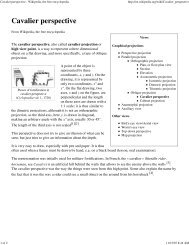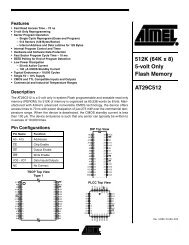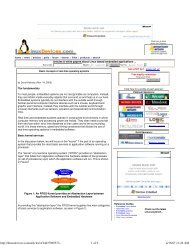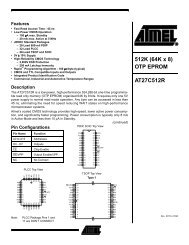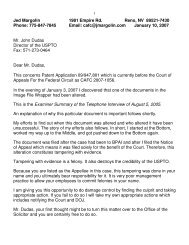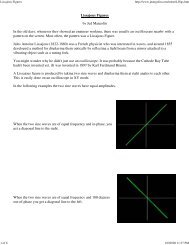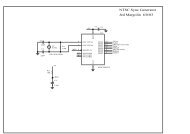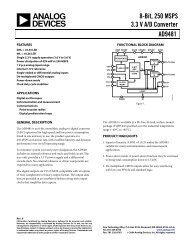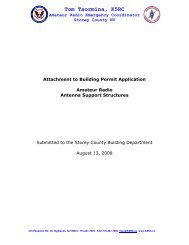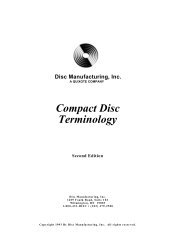You also want an ePaper? Increase the reach of your titles
YUMPU automatically turns print PDFs into web optimized ePapers that Google loves.
JED MARGOLIN,<br />
vs.<br />
Case 3:09-cv-00421-LRH-VPC <strong>Document</strong> <strong>39</strong> Filed 06/10/10 Page 1 of 3<br />
Plaintiff(s),<br />
NATIONAL AERONAUTICS AND SPACE<br />
ADMINISTRATION, et al.,<br />
Defendant(s).<br />
PRESENT:<br />
The Honorable Larry R. Hicks , U.S. District Judge<br />
UNITED STATES DISTRICT COURT<br />
DISTRICT OF NEVADA<br />
3:09−cv−00421−LRH−VPC<br />
MINUTES OF THE COURT<br />
June 10, 2010<br />
Deputy Clerk: Marti Campbell Recorder/Reporter: None Appearing<br />
Counsel for Plaintiff(s): None Appearing Counsel for Defendant(s): None Appearing<br />
MINUTE ORDER IN CHAMBERS<br />
REGARDING THE REQUIREMENTS OF<br />
Klingele v. Eikenberry and Rand v. Rowland: XXX<br />
A party or parties have filed a motion to dismiss, motion for judgment on the pleadings, or a motion for<br />
summary judgment. These are known as “dispositive motions,” for they may terminate either some portion or all of<br />
this lawsuit, if granted. This notice is given to all parties to this litigation, and particularly to the party against whom<br />
the above referenced motion has been filed, pursuant to the requirements of Klingele v. Eikenberry, 849 F.2d 409<br />
(9th Cir. 1988), and Rand v. Rowland, 154 F.3d 952 (9th Cir. 1998).<br />
Pursuant to the last sentence in Fed. R. Civ. P. 12(b), if evidence is submitted with a motion to dismiss and<br />
considered by the court, then the motion will be treated as a motion for summary judgment. The same is true<br />
regarding a motion for judgment on the pleadings. See Fed. R. Civ. P. 12(c). This notice is issued, in part, to alert<br />
the plaintiff that if defendants have submitted evidence in support of a motion to dismiss or a motion for<br />
judgment on the pleadings, then the court may treat the pending motion as a motion for summary judgment.<br />
If the court grants summary judgment, then judgment may be entered against plaintiff and this lawsuit will<br />
end without trial. This notice contains important information about what you need to do to oppose the motion.<br />
Please read it carefully.<br />
MINUTE ORDER IN CHAMBERS re: Klingele v. Eikenberry and Rand v. Rowland − 1
Case 3:09-cv-00421-LRH-VPC <strong>Document</strong> <strong>39</strong> Filed 06/10/10 Page 2 of 3<br />
Motion to Dismiss-Fed. R. Civ. P. 12(b)(6)<br />
If the party or parties which filed the motion (hereinafter the “moving party”) have filed a motion to dismiss<br />
pursuant to Fed. R. Civ. P. 12(b)(6), the party or parties against whom that motion is filed (hereinafter, the<br />
“non-moving party”) must file points and authorities in opposition to that motion within fourteen (14) days after<br />
service of the motion. Local Rule 7-2(b). The failure to file points and authorities in response to any motion shall<br />
constitute a consent to the granting of the motion. Local Rule 7-2(d). The court may then grant the motion and<br />
dismiss the non-moving party’s claims. If the non-moving party does not agree that its claims should be dismissed, it<br />
must file and serve points and authorities in opposition within fourteen (14) days from the date the moving party<br />
served the non-moving party with the motion.<br />
Motion for Judgment on the Pleadings-Fed. R. Civ. P. 12(c)<br />
If the moving party has filed a motion for judgment on the pleadings pursuant to Fed. R. Civ. P. 12(c), the<br />
non-moving party must file points and authorities in opposition to that motion for judgment within fourteen (14) days<br />
after service of the motion. Local Rule 7-2(b). The failure to file points and authorities in response to any motion<br />
shall constitute a consent to the granting of the motion. Local Rule 7-2(d). The court may then grant the motion and<br />
dismiss the non-moving party’s claims. If the non-moving party does not agree that its claims should be dismissed,<br />
the non-moving party must file and serve points and authorities in opposition within fourteen (14) days from the date<br />
the moving party served the non-moving party with the motion.<br />
Motion for Summary Judgment-Fed. R. Civ. P. 56<br />
If the moving party has filed a motion to dismiss under Fed. R. Civ. P. 12(b)(6) or a motion for judgment on<br />
the pleadings under Fed. R. Civ. P. 12(c) and attached admissible evidence to the motion, or if it has filed a motion<br />
for summary judgment under Fed. R. Civ. P. 56, then the non-moving party must properly oppose the motion, by<br />
filing opposing points and authorities, admissible evidence, and a statement of facts under Local Rule 56-1, within<br />
twenty−one (21) days after service of the motion. See Fed. R. Civ. P. 56, Local Rules 7-2(e) and 56-1. The<br />
standards governing motions for summary judgment are stated in Rule 56 of the Federal Rules of Civil Procedure.<br />
All parties should read that rule and be familiar with it.<br />
The Ninth Circuit Court of Appeals has directed that the following notice be given to you:<br />
A motion for summary judgment is a means through which the defendants seek to have your<br />
case dismissed. A motion for summary judgment under Rule 56 of the Federal Rules of Civil<br />
Procedure will, if granted, end your case.<br />
Federal Rule of Civil Procedure 56 tells you what you must do in order to oppose a motion for<br />
summary judgment. Generally, summary judgment must be granted when there is no genuine issue<br />
of material fact--that is, if there is no real dispute about any fact that would affect the result of your<br />
case, the party who asked for summary judgment is entitled to judgment as a matter of law, which<br />
will end your case. When a party you are suing makes a motion for summary judgment that is<br />
properly supported by declarations (or other sworn testimony), you cannot simply rely on what your<br />
complaint says. Instead, you must set out specific facts in the form of admissible evidence (such as<br />
affidavits, declarations, depositions, answers to interrogatories, or properly authenticated documents<br />
as provided in Rule 56(e)), that contradict the facts shown in the defendant's declarations and<br />
documents and show that there is a genuine issue of material fact for trial. If you do not submit your<br />
own evidence in opposition, summary judgment, if appropriate, may be entered against you. If<br />
summary judgment is granted, your case will be dismissed and there will be no trial.<br />
Rule 56-1 of the Local Rules for the United States District Court for the District of Nevada<br />
also requires, in addition, that you file with your opposition to a motion for summary judgment a<br />
statement of facts which you contend are or are not genuinely in issue in this summary judgment<br />
procedure. If you are opposing a summary judgment motion, you should review the opposing<br />
party’s Local Rule 56-1 statement of facts not genuinely in issue, and you should set forth in writing<br />
those facts (supported by specific citation to evidence in the record which you have attached to your<br />
motion or statement) which contradict the claims of the opposing party. In other words, you must<br />
provide the court a statement of facts supported by attached admissible evidence that demonstrates<br />
that the opposing party is not entitled to judgment against you.<br />
MINUTE ORDER IN CHAMBERS re: Klingele v. Eikenberry and Rand v. Rowland − 2
Case 3:09-cv-00421-LRH-VPC <strong>Document</strong> <strong>39</strong> Filed 06/10/10 Page 3 of 3<br />
If you are the party moving for summary judgment, you should set forth, in writing, a<br />
statement of material facts, not genuinely in issue (supported by specific citation to evidence in the<br />
record which you have attached to your motion or statement) which supports your claim for<br />
summary judgment. In so doing, you must show the court those material facts which can be proven<br />
with admissible evidence that demonstrate that you are entitled to have judgment entered in your<br />
favor at this time.<br />
If the non-moving party fails to oppose the motion within twenty−one (21) days, or if the<br />
non-moving party fails to submit evidence supporting its opposition, and if the motion for summary<br />
judgment has merit, that failure to file points and authorities in response to any motion shall<br />
constitute a consent to the granting of the motion. Local Rule 7-2(d). The court may then grant the<br />
motion and enter judgment. Local Rule 7-2(d).<br />
IT IS THEREFORE ORDERED that non-moving party or parties shall have fourteen (14) days, or<br />
twenty−one (21) days for a motion for summary judgment, from the date of this Minute Order within which to file<br />
and serve points and authorities (and any other required documents) in opposition to the pending dispositive motion<br />
pursuant to the instructions herein, and the moving party shall thereafter have seven (7) days, or fourteen (14) days<br />
for a motion for summary judgment, after filing of the opposing points and authorities within which to file and serve<br />
reply points and authorities (and any other required documents). The pending motion(s) shall then be submitted to<br />
the court for decision.<br />
LANCE S. WILSON, CLERK<br />
By: /s/ Marti Campbell<br />
Deputy Clerk<br />
MINUTE ORDER IN CHAMBERS re: Klingele v. Eikenberry and Rand v. Rowland − 3



